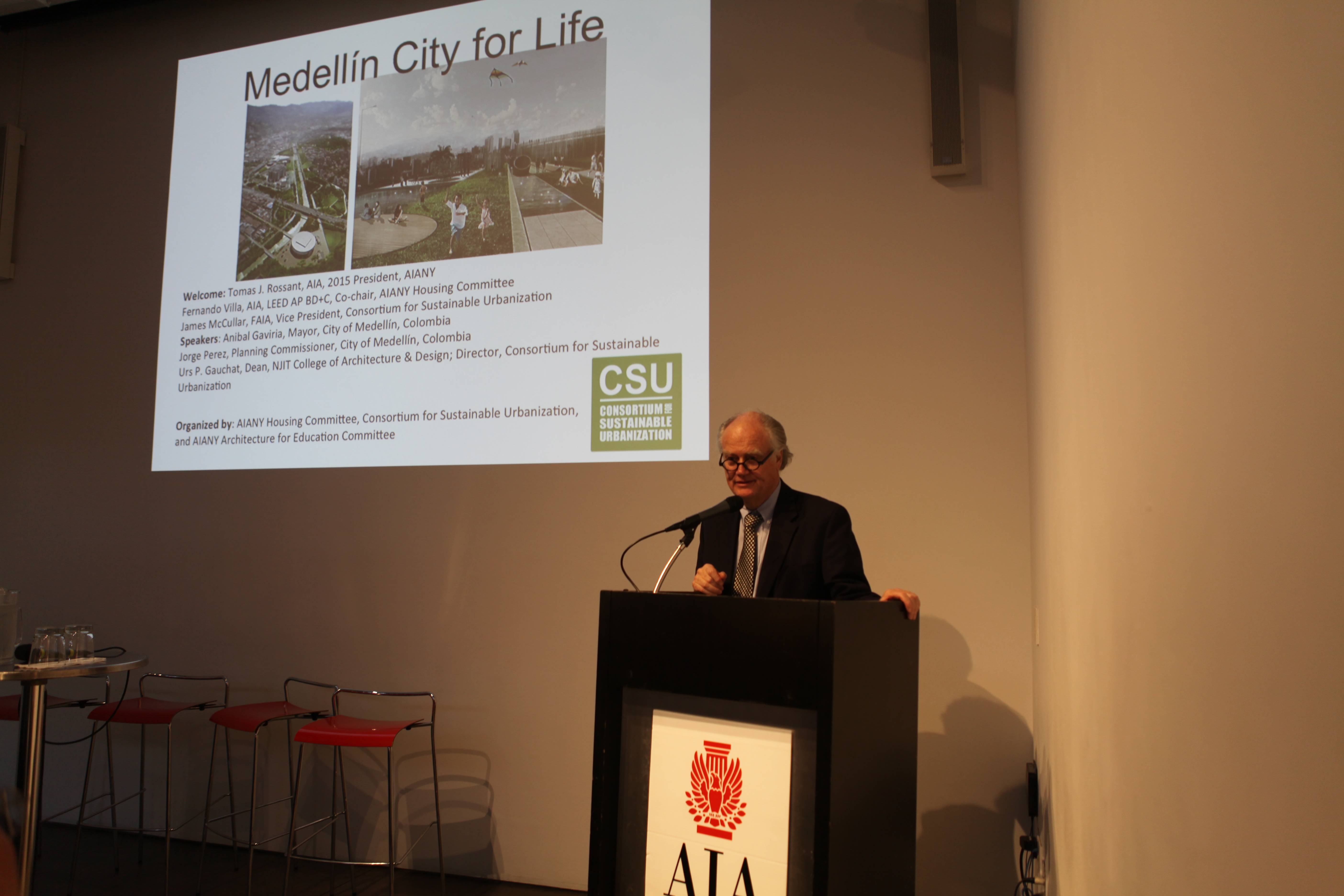by: Camila Schaulson Frenz
“The whole world is looking at Medellin,” notes NJIT College of Architecture and Design Dean Urs Gauchat. Given the laudatory articles hyping the “Medellin Miracle,” the numerous awards given to many of its public buildings, and the city’s hosting of last year’s World Urban Forum, his bold statement is pretty spot on. At the 06.08.15 event organized by the AIANY Housing Committee, Medellin Mayor Anibal Gaviria and Planning Commissioner Jorge Perez discussed how the city has used architecture and design as a tool for social inclusion.
“25 years ago,” said Gaviria, “the city of Medellin was living its darkest night.” Following a period of sustained growth in the first half of the twentieth century, the city fell into crisis in the late 1970s as industries collapsed and corruption, drug trafficking, and violence ran rampant. In 1990, Medellin logged 6,349 reported homicides, making it the murder capital of the world. To Perez, that year marked a turning point for the city’s administration, who transformed the moment of crisis into an opportunity to reinvest in public services and think collectively and inclusively about Medellin’s future.
Medellin has a strong tradition of urban planning, strengthened by the leadership of the city’s main universities, the Universidad Pontificia Bolivariana and the Universidad Nacional. Today, even the theoretical backbone of Medellin’s governance model is based on the idea of five cities: the safe city, the sustainable city, the employed city, the healthy city, and the education city. In Medellin, architecture and urbanism are seen as public strategies – ways to foster a collective urban vision and build society. The goal, says Gaviria is to “superimpose these new ‘cities’ over old sites symbolizing violence and inequality.”
The architecture of many of Medellin’s latest public projects is, as Gauchat noted, “mouthwatering;” however, the city’s overall success is due to a shift away from merely constructing striking buildings and a push towards providing access through the built environment. New public structures, including the now-iconic Parque Biblioteca España by Giancarlo Mazzanti, are located in some of the city’s poorest informal settlements, providing inhabitants with much-needed services and a sense of pride for their neighborhood.
The Global Holcim Awards for Sustainable Construction recently awarded their top prize to the UVA Orfelinato, a project that turned a previously fenced off water tank into a community center. According to Gaviria, many of the city’s informal settlements were initially built around these tanks. Now that Medellin is more densely populated, they have become some of the only available sites in the city limits for creating public spaces. 20 more such UVAs are on the way, and there are 140 tanks ripe for development.
The current administration’s focus on improving access to the city and its services is also why Medellin’s government continues to invest in transportation infrastructure. The city’s innovative use of cable cars, once relegated to tourism, and escalators, conventionally used in malls and airports, to give access to poor neighborhoods on the hillsides has been incredibly successful, substantially minimizing the commutes of those living on the periphery. Medellin, a city in a valley, will soon open the Tranvía de Ayacucho, a pneumatic-wheeled streetcar that will beat the inclines of the city and connect to its growing public transportation network.
Medellin’s approach to services and accessibility is also a sustainability measure, a means to reprioritize densification and halt urban sprawl. Informal settlements tend to develop in the periphery, the mountains around the city, which threatens the rich biodiversity of the region. Medellin’s land use plan promotes inward growth, with river improvements to focus development around this amenity and a circular garden around the city limits to close urban growth while also bringing public spaces and facilities to citizens in more remote areas.
While Perez and Gaviria were excited to talk about their upcoming projects, they were also proud of what they and previous administrations had achieved so far. The homicide rate dropped to 380 in 2014, bringing Medellin down to the 49th most violent city instead of the first. According to Gaviria, if the current rate for 2015 persists, it will take Medellin out of the top 50 list altogether. Medellin is also experiencing its lowest poverty index in 11 years and its lowest unemployment index in 18 years. Of course, this is not only due to architecture. 87% of Medellin’s budget is allocated to social investment, including education, healthcare, and, of course, the creation of public spaces and buildings.
Gaviria hopes that Medellin’s transformation will serve as a source of inspiration to cities in Latin America and all over the world. “Painfully,” said Gaviria, “violence and inequality are urban realities for much of Latin America.” 43 of the 50 most violent cities are located in the continent. The mayor hopes that others will follow the city’s example and realize that “when we build equality, we build a more peaceful city.”
Event: Medellin: City for Life
Location: Center for Architecture, 06.08.15
Speakers: Anibal Gavira, Mayor, City of Medellín, Colombia; Jorge Perez, Planning Commissioner, City of Medellín, Colombia; Urs P. Gauchat, Dean, NJIT College of Architecture & Design; Director, Consortium for Sustainable Urbanization; Fernando Villa, AIA, LEED AP BD+C, Co-chair, AIANY Housing Committee; and James McCullar, FAIA, Vice President, Consortium for Sustainable Urbanization
Organized by: AIANY Housing Committee, Consortium for Sustainable Urbanism, and AIANY Architecture for Education Committee










